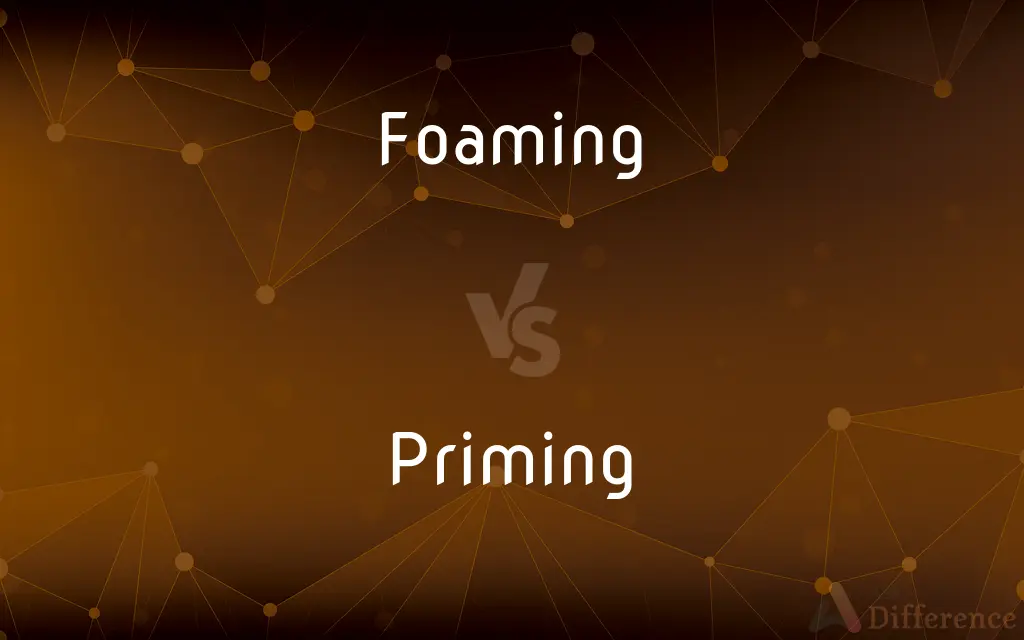Foaming vs. Priming — What's the Difference?
By Tayyaba Rehman & Maham Liaqat — Updated on April 24, 2024
Foaming involves the formation of a stable mass of bubbles, often seen in liquids like soap, while priming prepares a surface or device for subsequent processes, enhancing performance or adherence.

Difference Between Foaming and Priming
Table of Contents
ADVERTISEMENT
Key Differences
Foaming typically occurs when air or gas is trapped in a liquid, creating bubbles, which can be seen in products like shampoo or during fermentation. On the other hand, priming is a preparatory step, used to ready surfaces for painting or to initiate the functionality of pumps and engines.
In industrial applications, foaming is often undesirable as it can cause mechanical failures or product defects, whereas priming is essential for ensuring optimal operation of machinery by facilitating the proper flow of fluids.
The control of foaming often requires antifoaming agents or specific process adjustments to prevent excessive bubble formation. Conversely, priming might involve applying a base coat or conducting preliminary runs to ensure systems operate smoothly.
In consumer products, foaming is sometimes engineered to enhance the sensory experience and efficacy of products like toothpaste and detergents. Meanwhile, priming in cosmetics, such as primers for makeup, enhances the longevity and appearance of the products applied over them.
Environmental factors influence both processes differently; for example, temperature and impurities can exacerbate foaming, whereas for priming, environmental conditions like humidity and temperature need to be controlled to achieve the desired results.
ADVERTISEMENT
Comparison Chart
Definition
Formation of a mass of small bubbles.
Preparatory action to enhance performance.
Applications
Beverages, cleaning agents, fermentation.
Painting, makeup, machinery.
Purpose
Often sensory or efficacy in products.
Enhances adherence or operational readiness.
Control Methods
Antifoaming agents, process adjustments.
Base coats, preliminary runs.
Influenced by
Temperature, surfactants, mechanical agitation.
Environmental conditions, surface preparation.
Compare with Definitions
Foaming
Unintended consequence in industrial systems leading to inefficiencies.
Foaming in cooling systems can cause engine overheating.
Priming
Application of a preparatory coat to ensure better adhesion of subsequent layers.
Priming the canvas before painting helps the acrylic colors pop.
Foaming
A feature enhanced in consumer products for improved sensory appeal.
The foaming quality of this facial wash makes it very satisfying to use.
Priming
Preparation of equipment or machinery for optimal performance.
Priming the engine before startup enhances its longevity.
Foaming
Process in which gas is dispersed in a liquid, creating a light, airy mass.
Foaming in laundry detergents helps lift dirt from clothes.
Priming
Act of preparing or conditioning a surface or device before use.
Priming the wall before painting ensures a smoother finish.
Foaming
A common occurrence in biological processes, such as fermentation.
Foaming is a sign of active yeast in beer brewing.
Priming
A technique used in cosmetics to improve the durability of makeup.
Priming her face with a good primer prevented her makeup from fading.
Foaming
Formation of bubbles in liquids due to physical agitation or chemical reaction.
Foaming of the sea occurs as waves crash against the shore.
Priming
Initial steps taken to start a process, such as a pump.
Priming the pump is essential to avoid dry running.
Foaming
A colloidal dispersion of a gas in a liquid or solid medium, such as shaving cream, foam rubber, or a substance used to fight fires. A foam may be produced, especially on the surface of a liquid, by agitation or by a chemical reaction, such as fermentation.
Priming
The act of one that primes.
Foaming
Any of various light, porous, semirigid or spongy materials, usually the solidified form of a liquid full of gas bubbles, used as a building material or for thermal insulation or shock absorption, as in packaging.
Priming
The explosive used to ignite a charge.
Foaming
Frothy saliva produced especially as a result of physical exertion or a pathological condition.
Priming
A preliminary coat of paint or size applied to a surface.
Foaming
The frothy sweat of a horse or other equine animal.
Priming
(psychology) The implicit memory effect in which exposure to a stimulus influences response to a subsequent stimulus.
Foaming
The sea.
Priming
A substance used as a primer.
Foaming
To produce or issue as foam; froth.
Priming
The powder or other combustible used to communicate fire to a charge of gunpowder, as in a firearm.
Foaming
To produce foam from the mouth, as from exertion or a pathological condition.
Priming
The carrying over of water, with the steam, from the boiler, as into the cylinder.
Foaming
To be extremely angry; rage
Was foaming over the disastrous budget cuts.
Priming
Present participle of prime
Foaming
To teem; seethe
A playground foaming with third graders.
Priming
The powder or other combustible used to communicate fire to a charge of gunpowder, as in a firearm.
Foaming
To cause to produce foam.
Priming
The first coating of color, size, or the like, laid on canvas, or on a building, or other surface.
Foaming
To cause to become foam.
Priming
The carrying over of water, with the steam, from the boiler, as into the cylinder.
Foaming
Present participle of foam
Priming
The act of making something ready
Foaming
A process that forms foam.
Priming
Any igniter that is used to initiate the burning of a propellant
Foaming
Giving off bubbles and developing a head of foam; as, a foaming glass of beer.
Priming
The first or preliminary coat of paint or size applied to a surface
Foaming
Emitting or filled with bubbles as from carbonation or fermentation;
Bubbling champagne
Foamy (or frothy) beer
Foaming
Producing or covered with lathery sweat or saliva from exhaustion or disease;
The rabid animal's frothing mouth
Foaming
Covered with or resembling small bubbles as from being agitated by beating or heating;
The bubbling candy mixture
A cup of foaming cocoa
Frothy milkshakes
Frothy waves
Spumy surf
Common Curiosities
Can priming be used in systems other than painting?
Yes, priming is also crucial in mechanical systems like pumps and engines to ensure proper function.
How can foaming be controlled?
Foaming can be controlled using antifoaming agents or by modifying processing conditions.
Does temperature affect foaming?
Yes, temperature can influence the rate and stability of foam formation.
What is the purpose of priming before painting?
Priming helps ensure better paint adhesion and a more even finish.
Is foaming always undesirable?
Not always; in some products like shampoos and soaps, foaming is desirable for its sensory appeal.
What types of primers are used in cosmetics?
There are face primers, eye primers, and lip primers, each formulated to improve the finish and durability of makeup.
What causes foaming in liquids?
Foaming is caused by gas bubbles being trapped during agitation or chemical reactions.
Are there any disadvantages to excessive foaming?
Excessive foaming can lead to inefficiencies and mechanical failures in industrial processes.
What is the role of surfactants in foaming?
Surfactants reduce surface tension, which can increase or stabilize foam.
Can foaming be a sign of contamination?
Yes, in some industrial processes, unexpected foaming can indicate contamination.
How does priming affect the longevity of mechanical equipment?
Proper priming can prevent wear and tear, enhancing the equipment's longevity and performance.
What are the benefits of using a makeup primer?
Makeup primer creates a smooth base for makeup application and increases its longevity.
How does one prime a pump?
To prime a pump, fill the pump and intake line with fluid to remove air before starting.
Can environmental factors affect priming?
Yes, factors like humidity and temperature can affect the effectiveness of priming.
Is there a way to measure the effectiveness of a primer?
Effectiveness can be measured by the durability and quality of the finish or by operational metrics in machinery.
Share Your Discovery

Previous Comparison
Grill vs. Louver
Next Comparison
Boon vs. BaneAuthor Spotlight
Written by
Tayyaba RehmanTayyaba Rehman is a distinguished writer, currently serving as a primary contributor to askdifference.com. As a researcher in semantics and etymology, Tayyaba's passion for the complexity of languages and their distinctions has found a perfect home on the platform. Tayyaba delves into the intricacies of language, distinguishing between commonly confused words and phrases, thereby providing clarity for readers worldwide.
Co-written by
Maham Liaqat













































